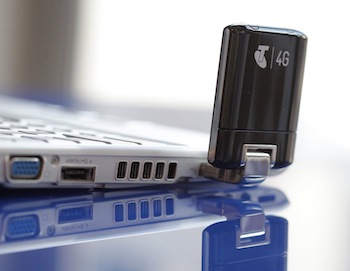|
|
"Telstra's 4G-enabled network is the next generation in mobile broadband and is set to offer Australians an even faster mobile connection," Thodey said. "The commercial pilot will give some of our customers a taste of the faster speeds, greater capacity and quicker response times that can be available for mobile services on 4G ahead of our national launch in major capital cities and selected regional centres later this year."

The Telstra LTE device will use dual mode LTE/3G HSPA technology enabling it to operate across the 1800MHz band of Telstra's LTE network and the 850MHz band, giving customers the benefits of LTE connectivity where it is available and switchover to HSPA technology across the rest of the Next G network.
The device will be available initially to account managed business customers in conjunction with a range of plans including for $0 upfront on the $49 Telstra Mobile Broadband Standard Plan over 24 months (minimum total cost $1,176) with 7GB included data.
Telstra is taking expressions of interest from customers who would like to be among the first to receive information about the national launch of the service in Australia. Customers can visit www.telstra.com.au/eoi/keep-informed/
Telstra announced in February that it would have LTE at 1800MHz available in capital city CBDs and major regional centres using network infrastructure from incumbent supplier Ericsson and dual LTE/HSPA USB dongles from Sierra Wireless by the end of 2011.
In May it announced that it had turned on the first, trial, base stations in its network, in Sydney, Melbourne, Brisbane and Perth, saying it planned to launch a commercial service by the end of 2011. The company made clear at the time that additional capacity, not the higher speeds available with LTE were its main priority.
CONTINUED
|
You can read more stories on telecommunications in our newsletter ExchangeDaily, click here to sign up for a free trial... |
|
"Ultimately, LTE will also provide faster data speeds, high quality video conferencing and faster response times for customers using mobile applications and the Internet on this network. However, the biggest benefit it will bring is additional capacity, meaning more customers can do more things on the network at the same time."
In using the term '4G' to describe its LTE network Telstra has followed the path of almost every other operator of LTE or mobile WiMAX services in misusing the term. In June ITU secretary general, Hamadoun Touré, told news service Total Telecom that none of the technologies currently on offer comply with the ITU's fourth-generation mobile standard.
He explained, as the ITU has repeatedly insisted: "4G is the commercial term applied to the [ITU's] IMT-Advanced standard, which is currently met by LTE-Advanced and WiMAX-Advanced [technologies]."
It is also possible that Telstra's misuse of the term could come back to bite it. Last month, Retrovo Gadgetoloy, the market research arm of US online electronics retailer Retrovo, concluded that "consumers may be so confused over 4G [LTE] that they become hesitant to move to 4G, at least in the near term."
A posting on the Retrovo blog: said: "In a recent Retrevo Gadgetology study only a little less than a quarter of the respondents say they're going for 4G. With so many potential 4G customers expressing concerns about cost and performance providers of 4G phones and services could be in for some disappointment."
It explains: "A third of iPhone owners mistakenly think their phones have 4G. Maybe the '4' in the iPhone 4 name gives iPhone owners (34 percent) the false impression that they already own a 4G phone but the fact is Apple doesn't offer a 4G phone at the moment.
"Coincidentally, a suspiciously large percentage of Android and BlackBerry owners may be suffering from the same delusion. BlackBerry owners (24 percent) are almost as confused as iPhone owners since RIM doesn't currently offer a 4G phone. At least some Android owners could be answering correctly as Android 4G phones like the HTC Evo 4G or Samsung Infuse 4G have been available for some time. If nothing else this large number of 'misinformed' phone owners serves to emphasise the fact that consumers are quite confused about 4G."
|





































